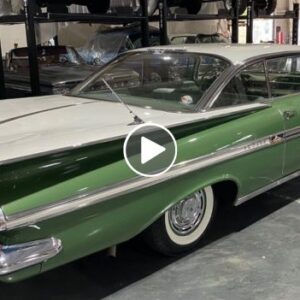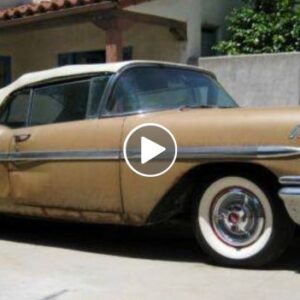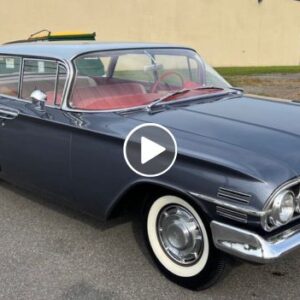Ask most muscle car enthusiasts to identify the car that kicked off the muscle car era, and they will most likely say it was the 1964 Pontiac GTO and not the 1962 Plymouth Fury Max Wedge. Why? Because dropping a high-powered big-displacement engine (the 413 Max Wedge or the Pontiac 389) into a relatively lightweight midsized production vehicle (the midsized Plymouth Fury or the Pontiac Tempest) was a novel concept. But like the old riddle goes, if a tree falls in the forest when no one’s around, does it make a sound? Apparently, it doesn’t.
Not to take anything away from Pontiac, but the formula for what we know as a “muscle car” happened two years earlier at Chrysler with not one, but two 1962 Max Wedge 413 models: the midsized Plymouth (the topic of this story) and the midsized Dodge. So why the historical discrepancy? It might not seem fair to Mopar fans, but Chrysler’s 1962 Max Wedge cars were not only available two years earlier, but they packed more power (410/420 hp versus the Pontiac’s 325 hp) and were available with a three-speed TorqueFlite 727 automatic versus the Pontiac’s optional two-speed Super Turbine 300. In point of fact, the GTO was a major performance downgrade from a Max Wedge, but Pontiac’s historical narrative runs deep in the enthusiast community because Pontiac won the public-relations war. As we’ll see, that narrative has legs to this day that spills over to inform early Max Wedge valuations
First Muscle Car: Pontiac GTO Or Max Wedge?

There are three main reasons history records the GTO as the first muscle car. We’ve already mentioned Pontiac’s 1964 resounding public-relations victory, but not the matter of production volume or intended use (racing versus street). In the case of the 1962 Plymouth 413 Super Stock, just 298 Max Wedge cars were built (all models), whereas Pontiac built 32,540 GTOs in its first year of 1964—over 100 times more. Although the Max Wedge-equipped cars were technically street-legal, they were sold with the understanding that they would be restricted to competition use while the GTO was not. It may not matter to us today, but price was also an issue; a Max Wedge-equipped 1962 Plymouth Fury had a base price around $3,308 (Fury base price plus the Max Wedge engine option), while the GTO base price in 1964 was only $2,491—a 33 percent premium for the Plymouth.
The Max Wedge Formula

The Max Wedge 413 story began in 1958 with Chrysler’s forward-looking powertrain planning. As good as the Hemi was, it was expensive, heavy, and complex. Engineers saw the flood of modern overhead-valve V8s coming and began developing the lightweight “B” series V8 big-block using a wedge-shaped combustion chamber for versions in 350 and 361 cubic inches. This provided the needed quench area for higher compression and greater power while reducing complexity and mass. By 1959, the B-series wedge spawned a taller deck version called the “RB” which became the basis of the 383/400/413/426/440 family of Mopars we’re familiar with today. Although the 413ci RB-series big-block wedge made its debut in 1959 in full-sized Chryslers, Dodges, and Plymouths, it wouldn’t be until 1962 that it gained its infamous induction in “Maximum Performance” form.

The Max Wedge engines were built in 413-cubic-inch form for 1962 only before increasing in size to 426 cubic inches for 1963 and 1964 (horsepower increased to 415 and 425, depending on compression ratio). Max Wedge sub-variants of the RB-series big-block wedge were principally differentiated from standard RB-series engines by their larger, raised intake ports, more aggressive camshaft, twin carburetion, and high compression (available in either 11:1 or 13.5:1). When the 426ci Race Hemi began production in 1964, the 426 Max Wedge was sidelined, making the Max Wedge a relatively short-lived phenomenon in spite of its notable racing success.
The Midsized B-Body Platform

Quite aside from the powertrain developments inside Chrysler engineering during the late 1950s, a sea change in the way Detroit approached vehicle mass was occurring. A recession at the end of the decade had many OEs rethink the policy of emphasizing full-sized car sales; times were tough, and customers demanded ever more fuel economy and affordability. By 1962, both Chrysler and Ford had introduced all-new midsized platforms to the public—the B-Body for Chrysler and the Fairlane for Ford. (GM came online with its similarly sized body-on-frame A-body in 1964 with the Chevy Chevelle, Pontiac Tempest, Olds F-85 Cutlass, and Buick Skylark.) And while Ford would sit on its hands with the midsized Fairlane for a languid two years before stuffing the R-code 427 tunnel-port FE into the Fairlane in 1964 to create the Thunderbolt, Plymouth and Dodge wasted no time pummeling the drag competition with the Max Wedge beginning in 1962. But less mass and more power were only part of Chrysler’s winning combination for Plymouth and Dodge.
The Three-Speed TorqueFlite Automatic

In a drag race, every millisecond counts, and shifting gears with a manual transmission had some benefits such as lighter weight and more closely spaced gear ratios (to keep the engine in its power band for a greater length of time). But manuals also had drawbacks like frequent failures, lost milliseconds from shifting, and the sudden death of a missed shift. An automatic could provide a distinct advantage, provided the gearbox was strong enough and employed the right gear ratios. At the time, Ford automatics were rarely in play at the dragstrip (the four-speed Toploader was the Ford racer’s go-to box as the three-speed MX Cruise-o-Matic was an unmitigated disaster). GM racers used the two-speed Super Turbine 300 with some success; it was a strong item, but it only packed a 1.76:1 First-gear ratio. When Chrysler’s Max Wedge Plymouths and Dodges entered the game in 1962, they packed Chrysler’s all-new 727 TorqueFlite three-speed, which was a real game changer. (A four-speed manual T-85 Borg Warner gearbox was also available in the Max Wedge. The A833 four-speed wouldn’t appear until 1963.)

With the TorqueFlite’s three gears versus the Super Turbine 300’s two gears, the 727 could keep the 413ci Max Wedge in the sweet spot of the power band for longer. Moreover, the TorqueFlite was practically indestructible relative to its competition and had an earth-rotating 2.54:1 First gear ratio. GM would not come to the racer’s rescue until 1964 (Buick and Cadillac only) with the equally stout Turbo Hydramatic 400, with Chevy getting the TH400 finally in 1965—three years after the Plymouth Max Wedge got the 727. Thus, Chrysler’s TorqueFlite-equipped cars ran roughshod over the competition unimpeded for three excruciating years. (Ford finally got its torque-transfer act together in 1966 with the three-speed C6.) Chrysler’s automatic transmission dominance with the TorqueFlite continued through the 1970s, with the 727 becoming the first high-torque three-speed automatic with fuel-saving torque-converter lockup in 1978.
Plymouth Fixes Its Styling

While the discussion to this point has ostensibly focused on Chrysler’s powertrain and engineering dominance of the early 1960s, it’s notable that Plymouth styling seemed to take a greater leap forward relative to Dodge for the first model year of the new Chrysler B-Body intermediates. At Dodge, the 1962 intermediates still exhibited vestiges of Virgil Exner’s “plucked-chicken” look, while Chrysler’s incoming styling chief Elwood Engel seemed to spend a good deal more effort focusing on the Plymouth intermediates (Savoy, Fury, Sport Fury, Belvedere). His simpler slab-sided tendencies would later define all of Chrysler’s muscle cars but are already evident in the transitional styling of the 1962 Plymouths.
Max Wedge Values

In an era where four-speed Hemi convertible E-Bodies are selling in the multi-million-dollar range and other Hemi cars (Plymouth Road Runners and Dodge Daytonas) are not far behind, it seems unbelievable that Max Wedge cars fail to break the six-figure mark. The 1962 Plymouth and Dodge Max Wedge cars mark the exact moment of the confluence of engineering, styling, marketing, competition, and a new generation of performance enthusiasts that gave birth to the muscle car era. Despite their rarity, 1962 Plymouth Max Wedge cars typically transact in the $35K-$85K range—not that wonderful for sellers but a hell of a bargain for buyers who prize rare, historically significant investment vehicles. Today, Plymouth and Chrysler Max Wedge cars from 1962-1964 offer collectors of more modest means an opportunity to enjoy a historical artifact of their own while benefiting from a solid capital investment.
1962 Plymouth Fury Max Wedge 413 Auction

This 1962 Max Wedge 413 Plymouth Fury was one of just 57 Max Wedge Plymouth Furys built and is being auctioned under reserve by Mecum in Harrisburg, Pennsylvania on Friday, July 28, 2023 as lot number F141.1. Tune in to MotorTrend TV and MotorTrend+ to see it cross the auction block, details below.
How to Watch the Mecum Auctions Harrisburg Event
- Live on MotorTrend TV and MotorTrend+: July 27-29 / 12-6 p.m. EST
- Sign up for a free trial to MotorTrend+ today!
413 Super Stock Max Wedge Engine

Max Wedge engines can be easily differentiated from ordinary RB-series wedges by their iconic upswept “ram’s horn” exhaust manifolds and cross-ram dual-quad carburetor setup. And for Max Wedge Plymouths, there’s no ignoring the “Super Stock 413” call-outs on the valve covers. Max Wedge Dodges featured “Ramcharger 413” valve cover call-outs.
1962 Plymouth Fury Max Wedge Undercarriage

According to its current owners, Larry Matthews and Cal Percy, this 1962 Plymouth Fury Max Wedge 413 was raced most of its life and was track champion at Firebird Raceway in Boise, Idaho, in the late ’60s and early ’70s, posting quarter-mile times of 11.81 at 120 mph. This one has undergone a complete rotisserie restoration as evidenced from the undercarriage.
Factory Max Wedge Dual Exhaust Cutouts

Unusual even for its day, the 1962-1964 Plymouth and Dodge Max Wedge cars featured unique dual exhaust cutouts to open up the exhaust for more power when drag racing.
Fast Facts: 1962 Plymouth Fury Max Wedge 413

- Vehicle Identification Number: 3321177385
- 1962 was the first year of the mid-sized Plymouth Fury after being a full-sized car from 1959 to 1961.
- 413-ci Max Wedge Plymouth and Dodge models were the first cars to be considered muscle cars—i.e. a mass-produced midsized car with a big-block V8 that is built specifically for high-performance use.
- 1962 was the first year for the famed Chrysler Max Wedge big-block V8 with 413 cubic inches. The 1962 Plymouth Fury’s 11:1 413-ci Super Stock 413 was rated at 410 hp, while the higher-compression 13.5:1 version for use with race fuel was rated at 420 hp. The Dodge version of the 413 Max Wedge was called the Ramcharger 413 but was otherwise identical.
- In 1963, Plymouth began offering the optional 426ci, 425-hp Max Wedge V-8 with the A883 four-speed transmission, and by 1964 the Plymouth Fury could be optioned with the race-only 426-cid, 425-hp Super Commando Hemi V-8.
- This 1962 Plymouth Fury Max Wedge was built as a two-door hardtop with the following options: vinyl trim code 245-251-253, standard push-button radio (361), heater/defroster (385), front seat belts (411), variable-speed wipers (429), wheel covers (451), Super Stock 413 package (500), and 750×14 four-ply tires (32), and had an MSRP of $3,693.60
- Just 57 Plymouth Furys were produced with the 11:1-compression 413 Max Wedge and only 298 Max Wedge Plymouths were produced in 1962 (in both compression ratios)
- The 413-ci Super Stock Max Wedge “Maximum Performance” big-block engine could be special ordered in any 1962 Plymouth model with the sole exception of a station wagon. This included the Savoy, Belvedere, Fury, and Sport Fury models.





